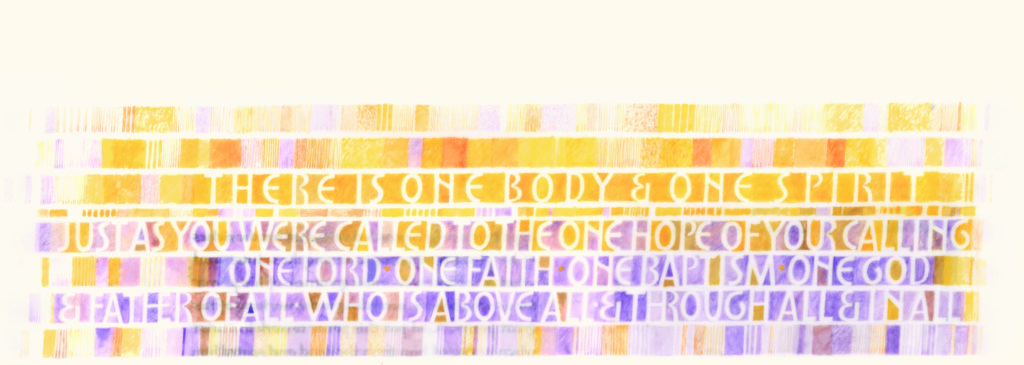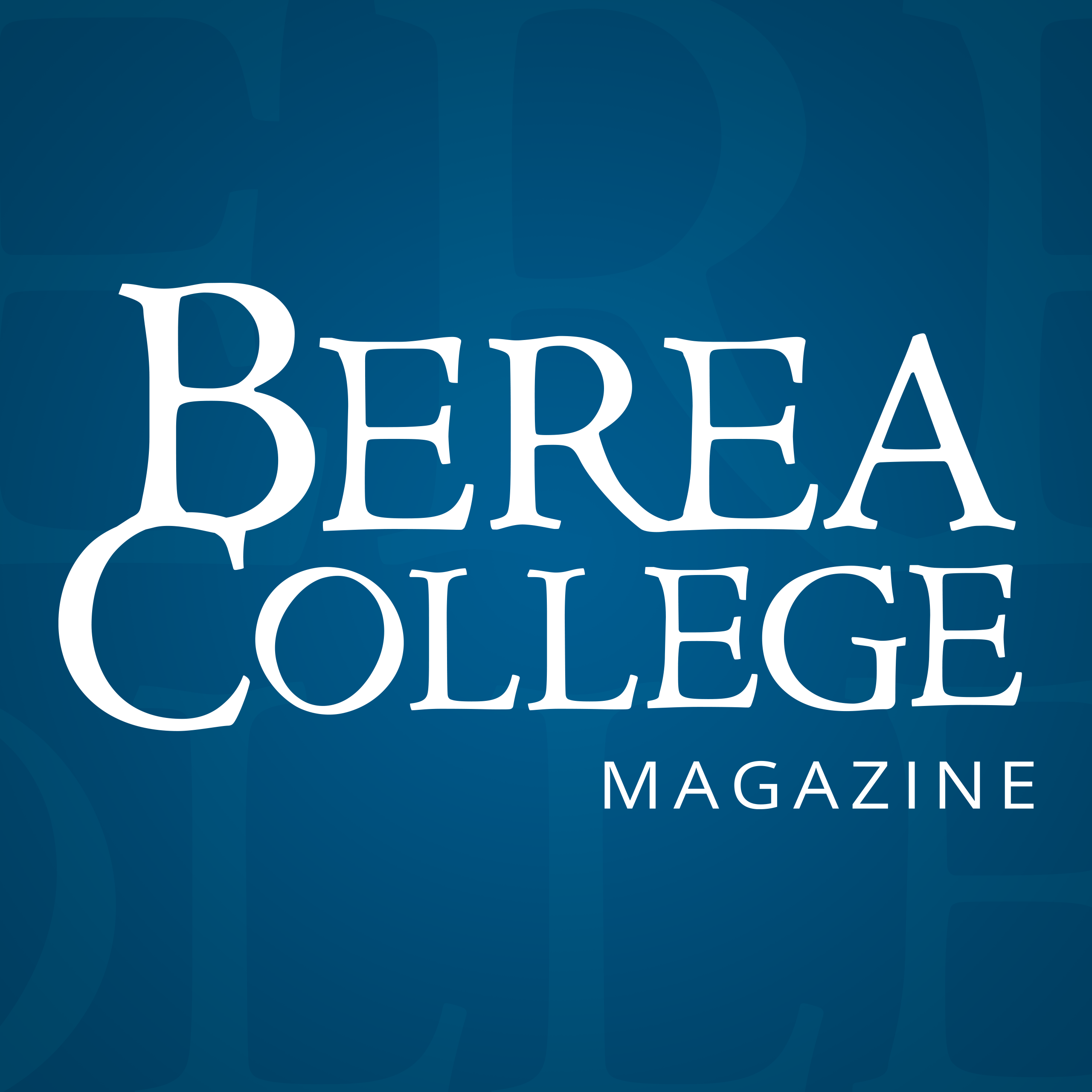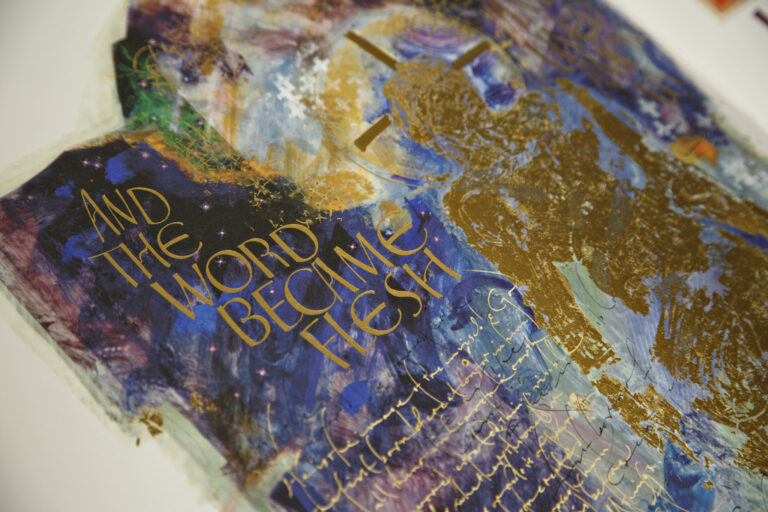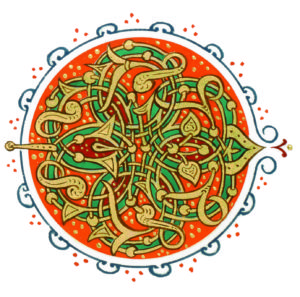Walking into any library can be an inspiring and humbling experience, but for the last year this has been intensified for those entering Berea College’s Hutchins Library.
Since 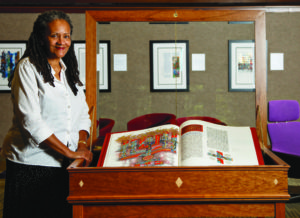 September of 2014 the entry way has been filled by a display of The Saint John’s Bible (SJB), a unique work of art that blends the wisdom of the Bible with the modern experience of the world, demonstrating that these are complimentary to one another rather than opposed.
September of 2014 the entry way has been filled by a display of The Saint John’s Bible (SJB), a unique work of art that blends the wisdom of the Bible with the modern experience of the world, demonstrating that these are complimentary to one another rather than opposed.
The display contains volume six of the Heritage Edition of the SJB, which is comprised of the three synoptic Gospels, John, and the Acts of the Apostles. The physical dimensions of the book are remarkable—it measures two feet high and three feet wide when open. But it is the calligraphy and illuminations within that make it truly distinctive. As the images here show, the SJB contains illustrations in diverse styles, ranging from the highly symbolic, like the menorah depicted on the first page of the Gospel of Matthew, to the realistic, nearly scientific, images of butterflies that adorn the two endings of Mark’s Gospel. What photographs can’t fully capture is the effect of the illuminations—illumination refers specifically to the use of gold leaf that has been burnished into the page, which is used in the SJB to represent the presence of the divine.

Created by Donald Jackson, officially titled Scribe and Calligrapher to the Crown Office, but often simply called the Queen’s Calligrapher, The Saint John’s Bible is both a work of love and a testament to faith in all its forms. Jackson’s vision, one that goes back to his childhood, was to create an illuminated copy of the Bible, a kind of work that had been produced only infrequently, and often partially, in the 500 years since Gutenberg’s printing press made the copying out of books by hand done in monasteries unnecessary. Jackson wanted more than to simply replicate the works of the past, he wanted to create a work that would engage the modern understanding of the world with the timeless spiritual truths found in the words of the Bible and in so doing to suggest, “the connectedness of all seekers of enlightenment”
(Sink 213).[/text_output][text_output]To achieve his vision, Jackson needed a sponsor who could underwrite the monumental undertaking. For this, he turned to the brothers at St. John’s Abbey in Collegeville, Minnesota, who, in 1996, had a desire to create a unique statement to celebrate the coming Millennium.
Having secured the Abbey’s support, work officially began on March 8, 2000 when Jackson inscribed the phrase, “In the beginning was the Word …” on a sheet of vellum (calfskin). Ultimately, the project involved the efforts of five additional calligraphers and more than 30 illustrators and other artists. Work was completed on May 9, 2011, and, today, because the individual pages have not yet been bound together, parts are on display in museums and libraries across the world.
To prevent this treasure from being exclusive to a very small segment of the population, Jackson and the Abbey created 299 special art prints of the original that replicate it in almost every way, right down to the appearance of “bleed through” of ink on the back of each page. Much more so than a typical art reproduction, each of the Heritage Editions is a unique work of art in its own right. For example, the gold filaments used to represent that divine throughout the work have to be applied by hand; thus, no two copies are exactly alike.
Coming to Berea
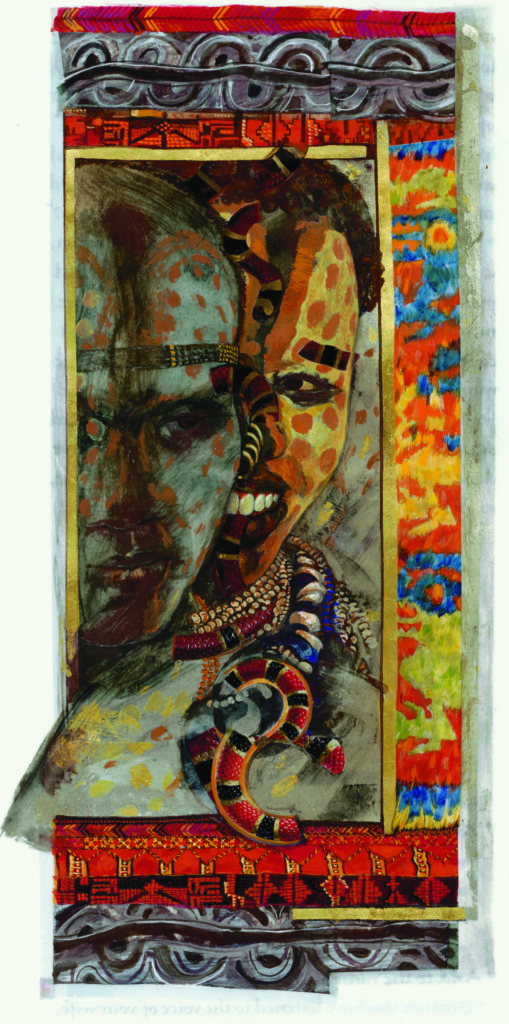
How then did such a work, envisioned by a Welshman and supported by an Abbey in Minnesota, find its way to a small college in the South? Largely through the work, determination, and vision of two women, Reverend Gail Bowman, director of the Willis D. Weatherford, Jr. Campus Christian Center (CCC), and Anne Chase, director of library services.
Bowman’s interest in the SJB began almost by chance. As she recalls it, during a visit to the Louisville Presbyterian Theological Seminary “I was walking by the bookstore and saw this picture of Adam and Eve—really, a picture of two Africans—and, I thought, ‘Well, what’s up with that?’ So I went in.” What she discovered was that the picture was the “Adam and Eve” illumination from The Saint John’s Bible. The image intentionally blends the modern understanding of humanity’s origins in East Africa with the Biblical story of the Garden of Eden. The image struck a chord with her. “It was immediately apparent to me that this was a whole new conversation about the Bible.”[/text_output][text_output]As director of the CCC, Bowman works to ensure the founding principles of the college are shared with students, faculty, staff, and the community beyond campus. Sharing that vision can be challenging, she notes because, “One of the things about Christianity that can be a struggle, to be honest with you, is that it invites passion, it invites very earnest thinking, and invites people to go deep, and stay down long. And by that I mean to say that people become very invested in their particular way of manifesting Christianity. Things get complicated when you get on the campus because you have countless different manifestations of Christianity going on all over the place, so there’s going to be, inevitably, some disagreement that stems from that. From time to time there’s going to be some pain, as people don’t see what they’d like to see, or see something that they would like not to see.”
Bowman constantly looks for ways to foster those campus conversations, so when she received an email from Saint John’s Abbey in November of 2013, asking if her institution would be interested in hosting a volume for a year, she was eager to participate. But to get it here and make certain that members of the community would see it, she would need allies of her own. What she didn’t know was that Chase had received the same email and was just as interested in bringing it to Berea as she was.
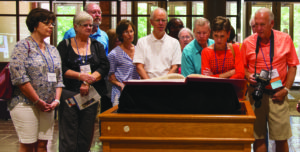
Though each responded to the email with an emphatic, “yes!” without consulting the other, “we got together and have been working in collaboration ever since,” says Bowman. “Our first thought was how to involve everyone who might want to be involved. We talked our way through the faculty—the Art folks, History, and Religion of course. We did not know what that might entail, but we did favor getting folks in on the ground floor, with us.”[/text_output][text_output]

One thing they knew for sure, “The Bible itself needed a unique display, a Berea display,” says Chase, and “the person who was recommended to us right away was Chester Mullins. Chester is one of the College’s wood artists; he supervises labor students in Student Crafts. We took the Bible over to him so he could see it and heft it. We explained that we needed a suitable display case. As it turned out, he agreed to do the work and did it gladly, beautifully, extraordinarily, and creatively.”
The collaboration with partners across campus allowed the SJB to be woven deeply into the campus conversation. Faculty members teaching GSTR 310, Understandings of Christianity, brought students to the library to interact directly with the book. Direct interaction, touching and manipulating the book, was essential to the success of the project, says Bowman. “It was new when it came to us and they, the people from the Abbey, said if we gave it back to them and there was no indication that it had ever been used, then we would have failed.”
The SJB was also the subject of several presentations over the course of the year including a convocation led by Tim Ternes, director of The Saint John’s Bible Project, and a presentation by Susan Sink, author of The Art of the Saint John’s Bible: The Complete Research Guide. Berea faculty members Edwin Broadhead, professor of religion, and Katharine Christensen, professor of history, presented as well. Broadhead spoke about a “paper trail” from the first century to the modern day Bible and the SJB. He began with the format of the Codex, spoke about the scribes and the pitfalls of copying Bibles by hand, and ended with the value of the SJB as a teaching tool. In her presentation, Christensen spoke about the evolution of written manuscripts, scrolls, and books from before the time of Christ clear up to the present day. She emphasized the significance of people writing out books by hand, that it is a craft, an art form, and a form of spiritual practice.[/text_output][text_output]
However, the SJB’s presence was not limited to campus. Early on the decision was made to send the Bible on ‘field trips’ to local churches. “I love that something went out from the college to be shared with the various local churches” says Bowman. It was particularly gratifying when the SJB came to churches attended by faculty and staff. “Church members take a great deal of pride when their college turns up at their church home. We all were glad to have made that happen.”
“Each church made different use of it and I thought that was reflective of those bodies. The freedom and creativity we found in The Saint John’s Bible, they found too. Every time it was different.” Some of that creativity may be attributable to the particular volume, Gospels and Acts. Bowman remarks, “It is image dense. It includes the genealogy of Jesus and that is the best starting point I have found for talking to people about the Bible. Of the seven volumes, this volume, volume 6, truly tells the Christian story.” And tells it in a way particularly appropriate for an institution that prides itself on the liberal arts education it provides.
“The images in the book suggest the relevance to the modern world in countless ways. And each image does this in some way that is unique to the others, so you get this constant full conversation through the images,” says Bowman. “A good example is ‘Loaves and Fishes’ in Mark. The fish are depicted as fossils, so the illumination speaks of an ancient time, yet the fact that we know them as fossils is a modern story. So it has one foot in the ancient world and another foot in the modern world. The swirling patterns are found in ancient Anasazi Native American basket weaving, and the fact that we know which native people did this is modern.”“There’s nothing I enjoy more than walking by and seeing two students either standing out by one of the pull-ups or at the Bible itself talking and exchanging ideas,” says Chase. Bowman adds, “It brought people together, working, who would not have ordinarily been able to or have had the opportunity to work together. It started conversations that wouldn’t have taken place. It made the entrance into Hutchins Library an exquisite statement about who we are as a college of inclusive Christianity. We found kindred souls, and I think we were guided to them and they were guided to us by God.”[/text_output][text_output]The slogan promoting the presence of the Bible in Berea was “Come and see what it says to you” which derives from the Latin phrase “visio divina” that means “divine seeing.” The SJB clearly fostered many opportunities for contemplation over the last year, and Bowman and Chase hope to find more allies who will help extend the conversation. “We have talked to on-campus groups and members of the Appalachian College Association about pooling resources to support a permanent home for the Heritage Edition,” says Bowman. “I truly believe it belongs here as part of our expression of inclusive Christianity.”
